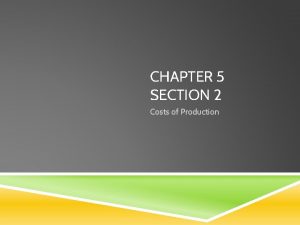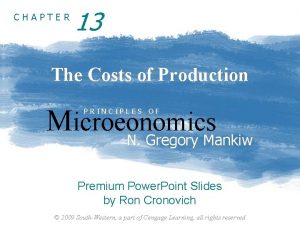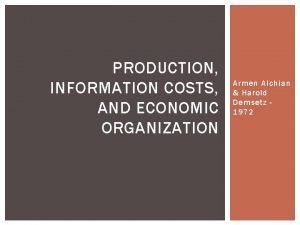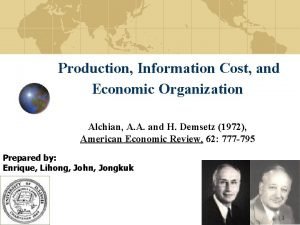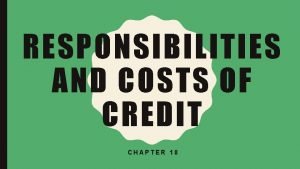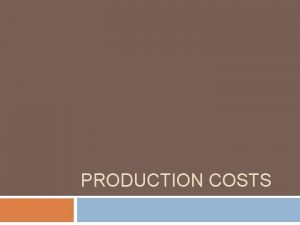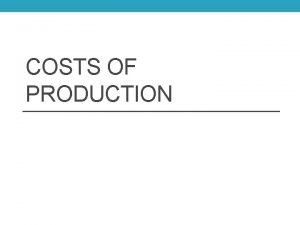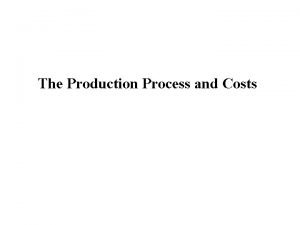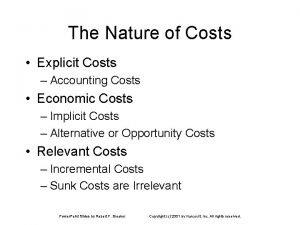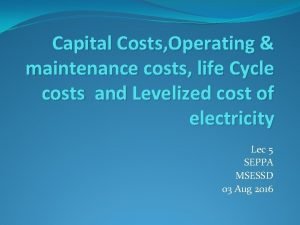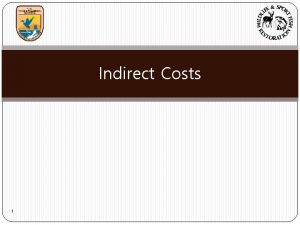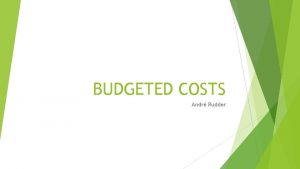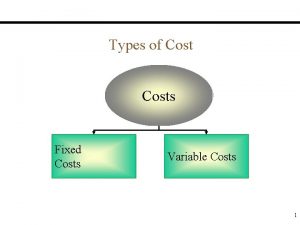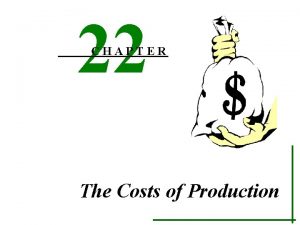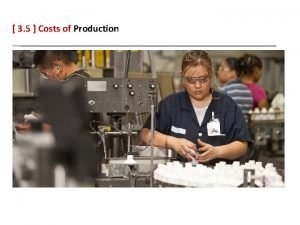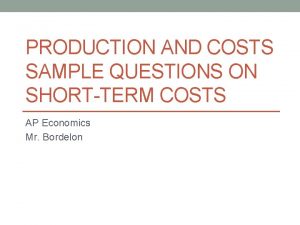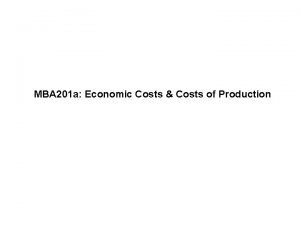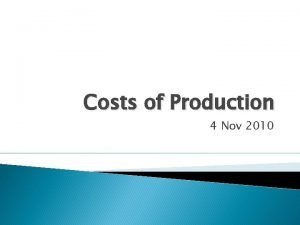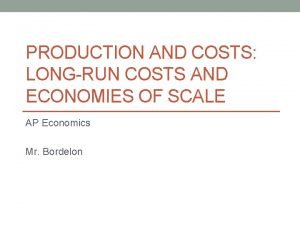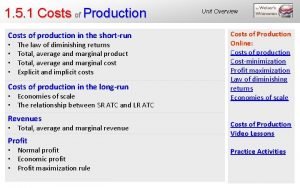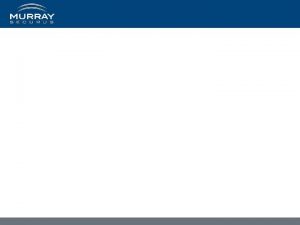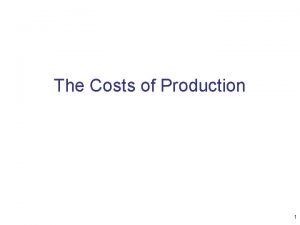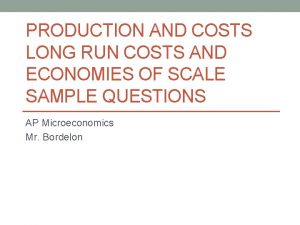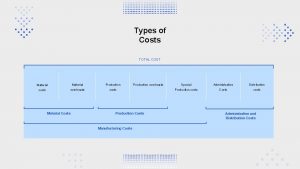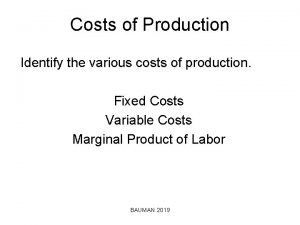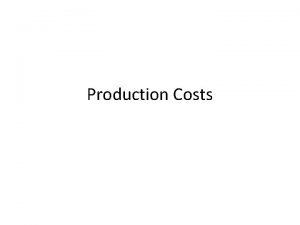Chapter 12 The Costs of Production What are


























- Slides: 26

Chapter 12 The Costs of Production

What are Costs? • Total revenue – Amount a firm receives for the sale of its output • Total cost – Market value of the inputs a firm uses in production • Profit – Total revenue minus total cost 2

What are Costs? • Costs as opportunity costs – The cost of something is what you give up to get it • Firm’s cost of production – Include all the opportunity costs • Making its output of goods and services 3

What are Costs? • Costs as opportunity costs • Explicit costs – Input costs that require an outlay of money by the firm • Implicit costs – Input costs that do not require an outlay of money by the firm 4

What are Costs? • The cost of capital as an opportunity cost – Implicit cost – Interest income not earned • On financial capital – Owned as saving – Invested in business • Not shown as cost by an accountant 5

What are Costs? • Economic profit – Total revenue minus total cost • Including both explicit and implicit costs • Accounting profit – Total revenue minus total explicit cost 6

Figure 1 Economists versus accountants Economists include all opportunity costs when analyzing a firm, whereas accountants measure only explicit costs. Therefore, economic profit is smaller than accounting profit 7

Production and Costs • Production function – Relationship between • Quantity of inputs used to make a good • And the quantity of output of that good – Gets flatter as production rises • Rational people think at the margin • Marginal product – Increase in output • Arising from an additional unit of input 8

Production and Costs • Diminishing marginal product – Marginal product of an input declines as the quantity of the input increases • Total-cost curve – Relationship between quantity produced and total costs – Gets steeper as the amount produced rises 9

Table 1 A production function and total cost: Caroline’s cookie factory Number of workers Output (quantity of cookies produced per hour) Marginal product of labor 0 1 2 3 4 5 6 0 50 90 120 140 155 50 40 30 20 10 5 Cost of factory $30 30 Cost of Total cost of inputs workers (cost of factory + cost of workers) $0 10 20 30 40 50 60 $30 40 50 60 70 80 90 10

Figure 2 Caroline’s production function and total-cost curve Quantity of Output (cookies per hour) (a) Production function 160 $90 70 120 60 100 50 80 40 60 30 40 20 20 10 1 2 3 4 5 6 Number of Workers Hired Total-cost curve 80 140 0 (b) Total-cost curve Total Cost 0 20 40 60 80 100 120 140 160 Quantity of Output (cookies per hour) The production function in panel (a) shows the relationship between the number of workers hired and the quantity of output produced. Here the number of workers hired (on the horizontal axis) is from the first column in Table 1, and the quantity of output produced (on the vertical axis) is from the second column. The production function gets flatter as the number of workers increases, which reflects diminishing marginal product. The total-cost curve in panel (b) shows the relationship between the quantity of output produced and total cost of production. Here the quantity of output produced (on the horizontal axis) is from the second column in Table 1, and the total cost (on the vertical axis) is from the sixth column. The total-cost curve gets steeper as the quantity of output increases because of diminishing marginal product. 11

The Various Measures of Cost • Fixed costs – Do not vary with the quantity of output produced • Variable costs – Vary with the quantity of output produced • Average fixed cost (AFC) – Fixed cost divided by the quantity of output • Average variable cost (AVC) – Variable cost divided by the quantity of output 12

Table 2 The various measures of cost: Conrad’s coffee shop Quantity of coffee (cups per hour) Total Cost Fixed Cost 0 1 2 3 4 5 6 7 8 9 10 $3. 00 3. 30 3. 80 4. 50 5. 40 6. 50 7. 80 9. 30 11. 00 12. 90 15. 00 $3. 00 3. 00 Average Marginal Variable Fixed Variable Total Cost Cost $0. 00 0. 30 0. 80 1. 50 2. 40 3. 50 4. 80 6. 30 8. 00 9. 90 12. 00 $3. 00 1. 50 1. 00 0. 75 0. 60 0. 50 0. 43 0. 38 0. 33 0. 30 $0. 30 0. 40 0. 50 0. 60 0. 70 0. 80 0. 90 1. 00 1. 10 1. 20 $3. 30 1. 90 1. 50 1. 35 1. 30 1. 33 1. 38 1. 43 1. 50 $0. 30 0. 50 0. 70 0. 90 1. 10 1. 30 1. 50 1. 70 1. 90 2. 10 13

Figure 3 Conrad’s total-cost curve Total Cost $15. 00 14. 00 13. 00 12. 00 11. 00 10. 00 9. 00 8. 00 7. 00 6. 00 5. 00 4. 00 3. 00 2. 00 1. 00 0 Total-cost curve 1 2 3 4 5 6 7 8 9 Quantity of Output 10 (cups of coffee per hour) Here the quantity of output produced (on the horizontal axis) is from the first column in Table 2, and the total cost (on the vertical axis) is from the second column. As in Figure 2, the total-cost curve gets steeper as the quantity of output increases because of diminishing marginal product. 14

The Various Measures of Cost • Average total cost (ATC) – Total cost divided by the quantity of output – Average total cost = Total cost / Quantity ATC = TC / Q • Marginal cost (MC) – Increase in total cost • Arising from an extra unit of production – Marginal cost = Change in total cost / Change in quantity MC = ΔTC / ΔQ 15

The Various Measures of Cost • Average total cost – Cost of a typical unit of output • If total cost is divided evenly over all the units produced • Marginal cost – Increase in total cost • From producing an additional unit of output 16

The Various Measures of Cost • Cost curves and their shapes • Rising marginal cost – Because of diminishing marginal product • U-shaped average total cost: ATC = AVC + AFC – always declines as output rises – AVC – typically rises as output increases • Diminishing marginal product – The bottom of the U-shape • At quantity that minimizes average total cost 17

The Various Measures of Cost • Cost curves and their shapes • Efficient scale – Quantity of output that minimizes average total cost • Relationship between MC and ATC – When MC < ATC: average total cost is falling – When MC > ATC: average total cost is rising – The marginal-cost curve crosses the averagetotal-cost curve at its minimum 18

Figure 4 Conrad’s average-cost and marginal-cost curves Costs $3. 50 3. 25 3. 00 2. 75 2. 50 2. 25 2. 00 1. 75 1. 50 1. 25 1. 00 0. 75 0. 50 0. 25 0 MC ATC AVC AFC 1 2 3 4 5 6 7 8 9 Quantity of Output 10 (cups of coffee per hour) This figure shows the average total cost (ATC), average fixed cost (AFC), average variable cost (AVC), and marginal cost (MC) for Conrad’s Coffee Shop. All of these curves are obtained by graphing the data in Table 2. These cost curves show three features that are typical of many firms: (1) Marginal cost rises with the quantity of output. (2) The average-total-cost curve is U-shaped. (3) The marginal-cost curve crosses the average-total-cost curve at the minimum of average total cost. 19

The Various Measures of Cost • Typical cost curves – Marginal cost eventually rises with the quantity of output – Average-total-cost curve is U-shaped – Marginal-cost curve crosses the average-totalcost curve at the minimum of average total cost 20

Figure 5 Cost curves for a typical firm Costs $3. 00 2. 50 MC 2. 00 1. 50 ATC 1. 00 AVC 0. 50 AFC 0 2 4 6 8 Quantity of Output 10 12 14 Many firms experience increasing marginal product before diminishing marginal product. As a result, they have cost curves shaped like those in this figure. Notice that marginal cost and 21 average variable cost fall for a while before starting to rise.

Costs in Short Run and in Long Run • Many decisions – Fixed in the short run – Variable in the long run, • Firms – greater flexibility in the long-run – Long-run cost curves • Differ from short-run cost curves • Much flatter than short-run cost curves – Short-run cost curves • Lie on or above the long-run cost curves 22

Figure 6 Average total cost in the short and long runs Average Total Cost ATC in short run with small factory ATC in short run with medium factory ATC in short run with large factory ATC in long run $12, 000 10, 000 Economies of scale 0 Constant returns to scale 1, 000 1, 200 Diseconomies of scale Quantity of Cars per Day Because fixed costs are variable in the long run, the average-total-cost curve in the short run differs from the average-total-cost curve in the long run. 23

Costs in Short Run and in Long Run • Economies of scale – Long-run average total cost falls as the quantity of output increases – Increasing specialization • Constant returns to scale – Long-run average total cost stays the same as the quantity of output changes 24

Costs in Short Run and in Long Run • Diseconomies of scale – Long-run average total cost rises as the quantity of output increases – Increasing coordination problems 25

Table 3 The many types of cost: A summary Mathematical Description Term Definition Explicit costs Costs that require an outlay of money by the firm Implicit costs Costs that do not require an outlay of money by the firm Fixed costs Costs that do not vary with the quantity of output produced FC Variable costs Costs that vary with the quantity of output produced VC Total cost The market value of all the inputs that a firm uses in production TC = FC + VC Average fixed cost Fixed cost divided by the quantity of output AFC = FC / Q Average variable cost Variable cost divided by the quantity of output AVC = VC / Q Average total cost Total cost divided by the quantity of output ATC = TC / Q Marginal cost The increase in total cost that arises from an extra unit of production MC = ΔTC / ΔQ 26
 Antigentest åre
Antigentest åre Alur proses produksi
Alur proses produksi Chapter 5 section 2 costs of production
Chapter 5 section 2 costs of production Chapter 13 the costs of production
Chapter 13 the costs of production Production, information costs, and economic organization
Production, information costs, and economic organization Types of cost savings
Types of cost savings Production, information costs, and economic organization
Production, information costs, and economic organization Chapter 18 responsibilities and costs of credit
Chapter 18 responsibilities and costs of credit Hát kết hợp bộ gõ cơ thể
Hát kết hợp bộ gõ cơ thể Bổ thể
Bổ thể Tỉ lệ cơ thể trẻ em
Tỉ lệ cơ thể trẻ em Voi kéo gỗ như thế nào
Voi kéo gỗ như thế nào Tư thế worms-breton
Tư thế worms-breton Chúa yêu trần thế alleluia
Chúa yêu trần thế alleluia Môn thể thao bắt đầu bằng từ đua
Môn thể thao bắt đầu bằng từ đua Thế nào là hệ số cao nhất
Thế nào là hệ số cao nhất Các châu lục và đại dương trên thế giới
Các châu lục và đại dương trên thế giới Công thức tiính động năng
Công thức tiính động năng Trời xanh đây là của chúng ta thể thơ
Trời xanh đây là của chúng ta thể thơ Mật thư anh em như thể tay chân
Mật thư anh em như thể tay chân 101012 bằng
101012 bằng độ dài liên kết
độ dài liên kết Các châu lục và đại dương trên thế giới
Các châu lục và đại dương trên thế giới Thơ thất ngôn tứ tuyệt đường luật
Thơ thất ngôn tứ tuyệt đường luật Quá trình desamine hóa có thể tạo ra
Quá trình desamine hóa có thể tạo ra Một số thể thơ truyền thống
Một số thể thơ truyền thống


